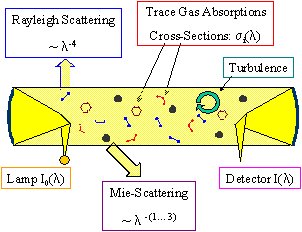
DOAS is a method to determine concentrations of trace gases by measuring their specific narrow band absorption structures in the UV and visible spectral region [Platt and Perner, 1983; Platt, 1994]. A typical DOAS instrument consists of a continuous light source, i.e. a Xe-arc lamp, and an optical setup to send and receive the light through the atmosphere [Platt, 1994]. It is also possible to use the sun or scattered sun light as light source. The typical length of the light path in the atmosphere ranges from several hundred meters to many kilometers.

After its path though the atmosphere the light is spectrally analyzed and the concentrations are derived. In the atmosphere the light of the lamp (I0(l )), undergoes extinction processes by air molecules (sRay(l )) and aerosols (sMie(l )), turbulence (T(l )), and absorption by many trace gases with the concentrations Ci and absorption cross sections si(l ). The light intensity from a path of length L can be described by:
The task of any spectroscopic method in the atmosphere is to separate these
effects in order to derive the concentrations of trace gases. DOAS overcomes
this problem by separating the trace gas absorption cross sections into
low and high frequency parts by specific numerical filtering methods (see
figure 2).
s (l )=sB
(l)+s ’(l )
By applying the same filtering routine to I(l
), a new I’0(l ) is defined which
contains the low frequency part of the spectrum (the extinction and turbulence
effects, as well as all broad band gas absorption structures).
The exponential term in eq 4 now only contains narrow absorption structures,
which are used by DOAS to determine the trace gases concentrations. By
calculating the differential absorption the concentration, Ci can
be derived:
Since normally many trace gases absorb in the same spectral region, i.e.
in the example of HONO and NO2, a numerical fitting procedure
is used to separate them [Stutz and Platt, 1997]. The following
figure shows differential absorption cross-section for some
of the trace gases that can be measured by DOAS. Figure 3: Differential absorption cross-sections of some trace gases absorbing
in the UV/vis wavelength region. On the right axis the dectection limits of the trace gases is listed together with
the typical light path lengths used to measure them. DOAS has proven its use in the past by identifying many trace gases
for the first time in the atmosphere, e.g. OH, NO3, HONO, BrO,
IO. It is still one of the most appropriate methods to measure HONO in
the open atmosphere.
Besides HONO, DOAS can also measure concentrations of many different
trace gases, most of them involved in photochemical smog formation; O3,
NO2, HCHO, HONO, H2O, NO3, SO2,
BrO, IO, OIO, and several aromatic hydrocarbons. Of special value for the
proposed study is the possibility of measuring HONO, together with its
precursors NO2 and H2O, simultaneously with the same
instrument.
Figure 4 shows a typical long-path DOAS instrument. The light of a Xe-arc
lamp is collimated into a parallel beam which is sent through the atmosphere
onto an array of quartz cube corner retroreflectors. The retroreflectors
send the light back into the telescope where it is received by the central
part of the double Newtonian telescope and focused onto a quartz fiber.
The fiber is part of a quartz fiber mode mixer whose other end serves as
entrance slit for the grating spectrometer. The spectrum is recorded by
a photodiode array and stored in a personal computer. The telescope, together
with the lamp and the fiber entrance, is mounted on a frame which can be
rotated ± 45° horizontally and ±
20° vertically by two stepper motors. By rotating, the instruments
can be aimed at different retroreflector arrays mounted at different heights.
Therefore the instrument can probe different air masses. picture : Jochen Stutz picture : Cathy Burgdorf
![]()
 Separation of broad and narrow part of an absorption
Separation of broad and narrow part of an absorption

![]()




References